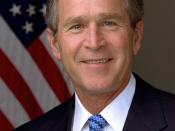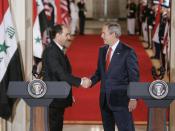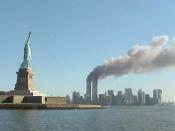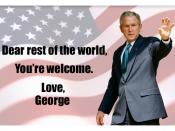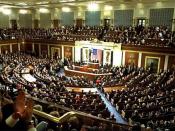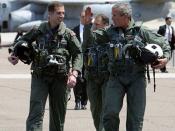On September 11th, 2001, Islamic terrorists attacked the World Trade Center in New York City, and the Pentagon building in Washington D.C. The terrorists, affiliated with Al Qaeda, were led by Osama bin Laden. On September 20th, nine days after the attack on the country, President George W. Bush addressed Congress with an impromptu State of the Union address. In this oration, Bush uses excessive amounts of pathos, which, when combined with multiple anaphoras and an urgently imperative tone, creates a product that reaches out to the American people as a whole in a call for not only remembrance, but action.
With America still reeling from the demolition of the Twin Towers, George W. Bush presented his information in a well-organized style that was punctuated with questions and answers. This served to give the President a more conversational tone, and made the tense audience much more relaxed. Many of the congressmen, indeed, much of the American people, had the same questions that Bush brought forward, and they clung to his every word in the hopes of shedding light upon the mystery of 9/11.
The questions were well chosen, as they allowed the President to steer the speech in a direction that would justify immediate action, as apposed to a more reserved, cautious approach.
Bush incriminated bin Laden and his cohorts of Al-Qaeda, and gave some statistics about the fatalities of the act of terrorism. These numbers had a dual purpose. The first, and most obvious, was the simple dissemination of information to the American public. The other, which would help Bush himself, was to evoke feelings of sympathy, sorrow, and most importantly horror in the common man. Once the average citizen was won over, usually using pathos, it would be a simple task for Bush to win over Congress.
One of the President's main applications of pathos was the way he employed individuals' names. For instance, he spoke of a passenger that help to rush the terrorists on the plane that crashed in Somerset County, a man named Todd Beamer. Using these names helps to personify the sorrow that the nation was feeling, Bush was able to focus these feelings into an energy which he could, and did, use. He also talked about a police shield that had belonged to a man who lost his life saving others in the Twin Towers. He said that he received the shield from the man's mom, which also helps to personify each individual family's loss. Another great use of pathos is Bush's reference to children of different countries. Children conjure up thoughts of innocence, which is well used in his quote: "We will not forget South Korean children gathering to pray outside our embassy in Seoul, or the prayers of sympathy offered at a mosque in Cairo." Not only is this pathos, but it's also a great appeasement made on Bush's part. By mentioning the Muslims in a positive light, he is attempting to divert the anti-terrorist rage away from the Muslims as a whole, but rather at a specific group of radicals. He does this many times throughout the speech.
Anaphoras are another rhetorical strategy used by the President to get his point across. George W. Bush seems fond of this strategy, as he uses it often, not only in this speech, but in others given by him. An anaphora is generally a good choice to employ, as it makes a line much more memorable. One memorable line from the President's speech was "They hate our freedoms - our freedom of religion, our freedom of speech, our freedom to vote and assemble and disagree with each other." This is also an example of tripartite structure, which is used effectively in Bush's message. Tripartite structure is a useful way to assemble sentences in order to make them more powerful, and memorable. Phrases such as "they follow in the path of fascism, and Nazism, and totalitarianism..." tend to stick in the audience's minds. Tripartite structure is also evident in "I will not yield; I will not rest; I will not relent in waging this struggle for freedom and security for the American people." This is not only tripartite structure, but it is filled with charged words as well.
These charged words are the backbone of Bush's address to the nation. Statements like "Our grief has turned to anger, and anger to resolution" evoke strong feelings within each and every person. Perhaps the most powerful of the President's assertions, however, is this: "Either you are with us, or you are with the terrorists." This, although it undoubtedly worked well at the time, is still under scrutiny today, and has landed the President in a number of tough situations. That sentence is also a good example of George W. Bush's tone. He is reverent and somber at times, and at others, full of fiery determination. Throughout the presentation, however, Bush stands resolute. He continually stresses the point of needing to "bring our enemies to justice, or bring justice to our enemies..." which fits in with his urgently imperative tone. He makes known the great import of acting now, and makes it evident that over thinking and delay will bring failure to the country's quest for vengeance.
George W. Bush's use of rhetorical strategies is admirable, regardless of whether one agrees or disagrees with his politics. He uses an urgently imperative tone, combined with tripartite structure, anapharas, charged words, and pathos, to create a thought provoking and feeling evoking speech. Looking back, it is evident that Bush used his effective speech as a stepping stone into Afghanistan, and later Iraq. The President even now continues to use rhetorical strategies in the debates against John Kerry, and only time will tell us the result of his efforts.
